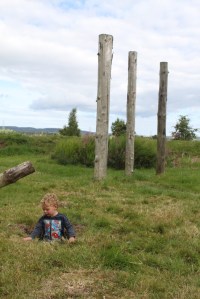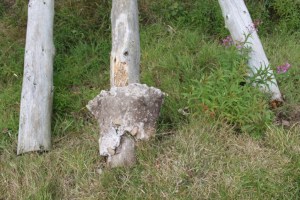From Howard Williams’s Archaeodeath blog.
I recently reported on the Maelmin Heritage Trail at Millfield, Northumberland. The trail consists of a dedicated segment of woodland and grassland as a refuge for a wide range of flora and fauna. The heritage boards along the trail outline the prehistoric and early historic development of the Millfield Basin with vivid artwork. The car park area fronting the trail has a memorial to the airmen who died during the Second World War at RAF Millfield.
My second visit recently gave me an opportunity to acquire a free copy of Clive Waddington’s guidebook which accompanies the trail. I lacked this for my previous posting. I also got to look around the heritage trail again with the Past in its Place group and discussions with them about its effectiveness were insightful.
The trail is certainly distinctive in attempting to capture something of the rich landscape history of what Hope-Taylor, in his book Yeavering of 1977, refers to as the ‘deep rhythms’ of this region. This is because, not only is Millfield a centre of Neolithic and Bronze Age ceremonial activity, but there are also traces of Iron Age and Roman period evidence. For the Anglo-Saxon period, Yeavering is now placed in context because of a series of excavations ahead of quarry extraction that have revealed lower-status settlements of comparable date.
The Past in the Past
If one minor criticism were to be levelled at the Maelmin Heritage Trail, it is one that is valid of many heritage sites, namely that there is no engagement with debates regarding the ‘past in the past’: how past people engaged with inherited material cultures, earthworks and monuments from earlier times. For example, prehistoric monuments like henges and burial mounds are described in and of their significance for the Neolithic, but not for subsequent periods when they might have been used and reused for different purposes.
This is an appropriate comment for the Maelmin site because the henge monuments that existed at Millfield had an interesting life and afterlife. Following excavation by Professor Anthony Harding, now of the University of Exeter, they were found to have attracted later activity. Both henges were reused for early Anglo-Saxon burials, presumably associated with the royal palace of Maelmin only known from aerial photographic evidence close by. At Yeavering itself, the traces of the henge attracted metalworking activities, where incidentally or deliberately. These are all instances of the early medieval reactivation and reuse of prehistoric monuments.
It remains a challenge for heritage sites like this one to articulate how these monuments sometimes had long sequences of activity straddling multiple time-periods, many are forgotten and abandoned, yet other times they were reactivated after long disuse with a new function and significance to that originally intended. Sadly, the structure and content of the Maelmin Heritage Trail cannot cope with this kind of temporal dynamic, and the same is true of many other heritage sites.
The same comment relates to other temporal rhythms. For example, for practical and fair reasons, the Anglo-Saxon building has no occupants, no artefacts, no associated ancillary structures, fences or other dwellings. Its thatched roof and timbers look well-maintained. Because of this, it is maintained but lacks an evident life-history for visitors to experience. Of course building such structures offers many insights in itself, and once constructed they help to spark the visitor’s imagination and provide a focus for the heritage trail. Yet this lonely bare structure does feel rather bereft of biography but for a thin scatter of straw on the floor. The building presents a challenge if we want to discuss time and memory in past communities.
The Biography of the Maelmin Heritage Trail’s Henge Monument
The state of the reconstructed henge itself reveals the complications of dealing with the biography of monuments. It is very hard for archaeologists to identify regular maintenance and easier to identify construction sequences and dramatic moments of destruction.
The reconstructed henge at the Maelmin Heritage Trail is under two decades old (constructed in 2000), partly using Neolithic technologies. Yet it requires maintenance and has been seemingly subject to criminal damage. In late June, I visited and all the timber posts were in place. Sometime in July or early/mid-August, many of the uprights have been dislodged and placed across the henge ditch. Whoever did this, damage to a mock-heritage site is a complex issue, certainly a crime and a shame.
Still, there are positive dimensions to this damage; because such interventions at least remind us that monuments like this in the past were never static: they were subject to the elements, embellishment and alternations, decay and all manner of destructive human action. On another positive note, this gave my son the opportunity to explore the post-holes.









